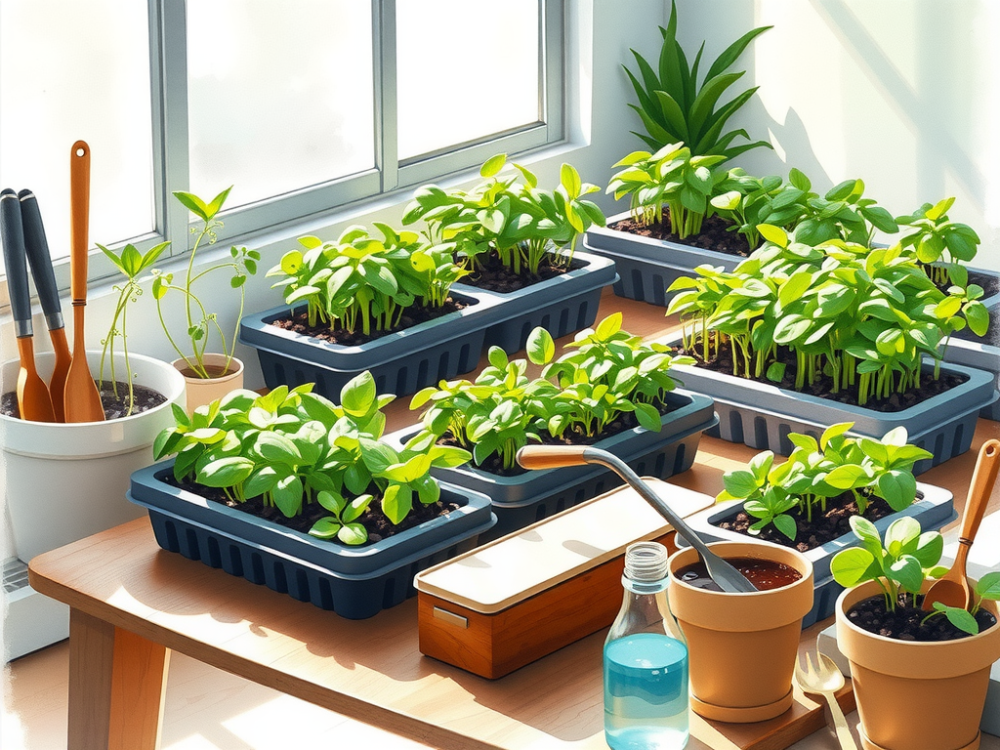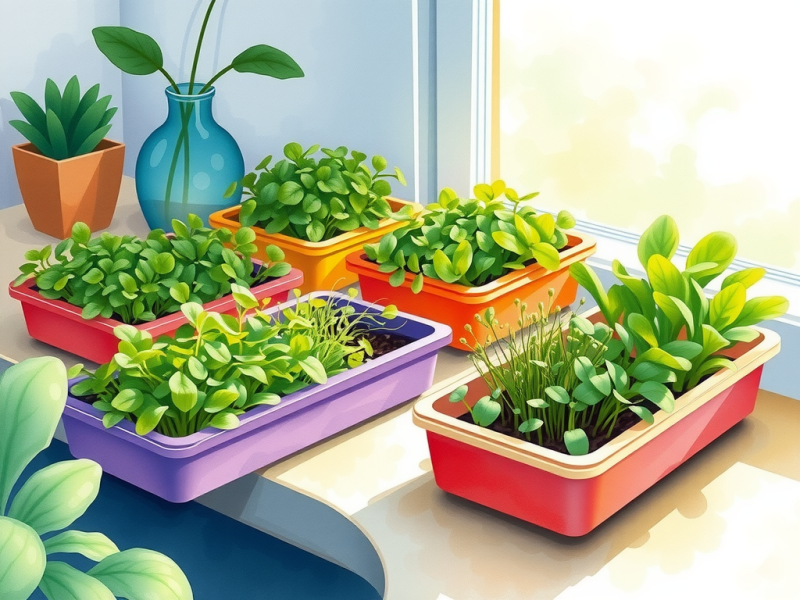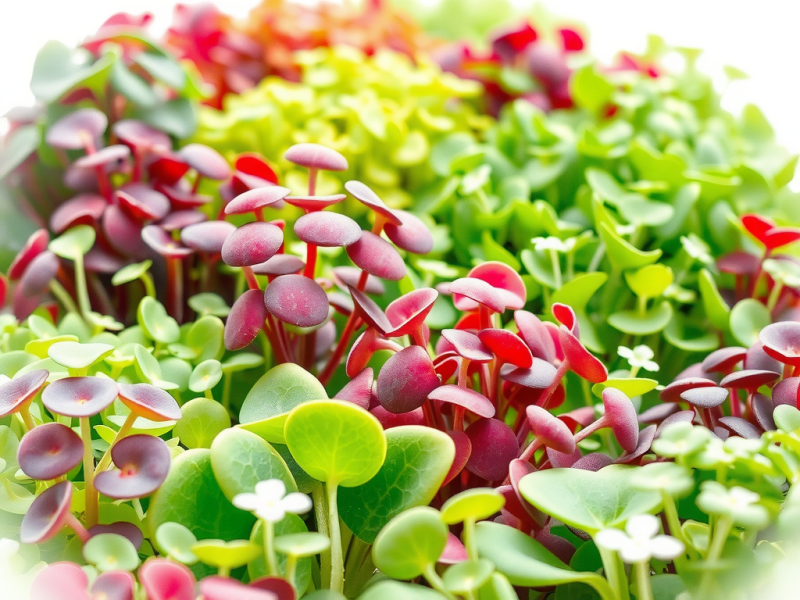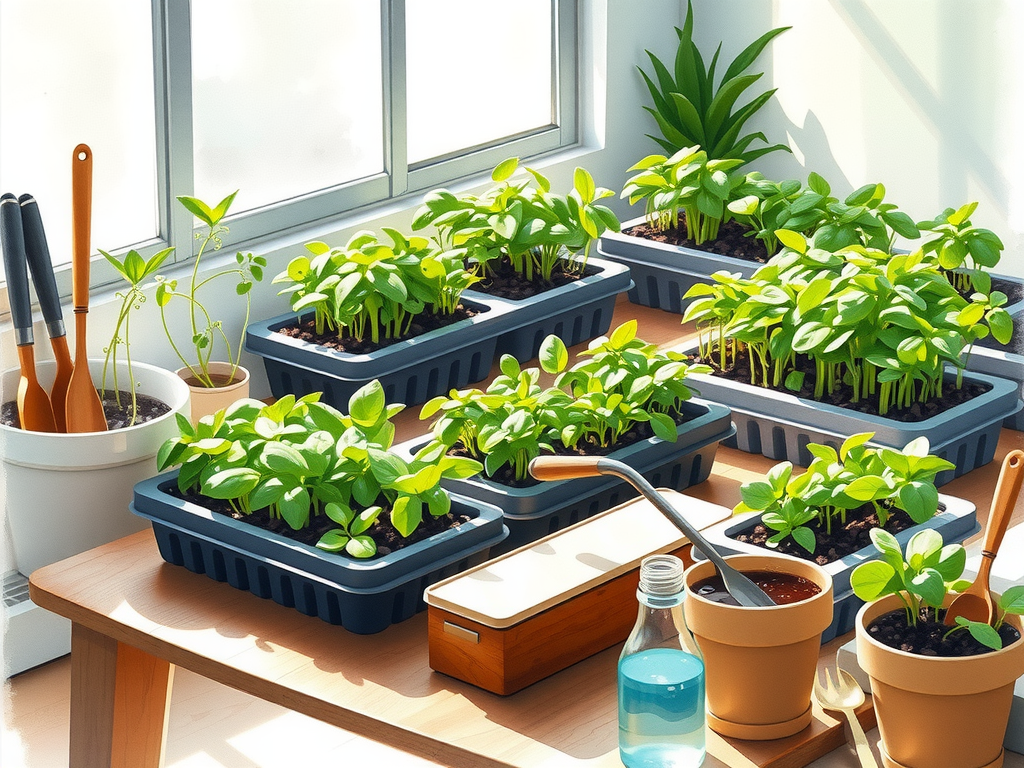
Microgreens are young plants that are harvested early. They are nutrient-dense and quick-growing, making them perfect for new gardeners.
Beginners can easily grow pea shoots and radish microgreens.
These varieties are rewarding and add great flavor to meals.
With a simple growing medium and some care, anyone can enjoy fresh greens at home. This guide showcases the best microgreens and tips for growth.
Choosing Easy-to-Grow Microgreens
Selecting the right microgreens matters for success.
Start with varieties that thrive in your local climate. Radishes and pea shoots are great choices due to their fast growth and minimal care.
Use quality soil or coconut coir as a growing medium for healthy development.
Choose simple containers like trays or recycled pots to minimize hassle.
Building confidence with these varieties enhances your home gardening journey.
Best Varieties for Beginners
- Pea Shoots: Sweet flavor and quick growth.
- Sunflower Greens: Nutty taste and high in protein.
- Broccoli Sprouts: Full of sulforaphane and easy to grow.
- Radish Microgreens: Spicy flavor and colorful.
- Arugula Leaves: Adds a peppery kick to dishes.
Growing Tips for Success
Microgreens can be grown in small indoor spaces. They need sufficient light and moisture to grow well. Keep the germination process simple by providing a blackout period for seeds. Regular watering is important, but avoid overwatering to stop mold. These nutrient-rich greens can be harvested in 1 to 3 weeks, making them a quick source of fresh greens.
Culinary Uses
Microgreens are versatile and enhance many dishes. They can be used in salads, sandwiches, and wraps. Add them as garnishes for extra flavor and texture.
With their antioxidant properties, they contribute to a healthy lifestyle and are a great addition to meals.
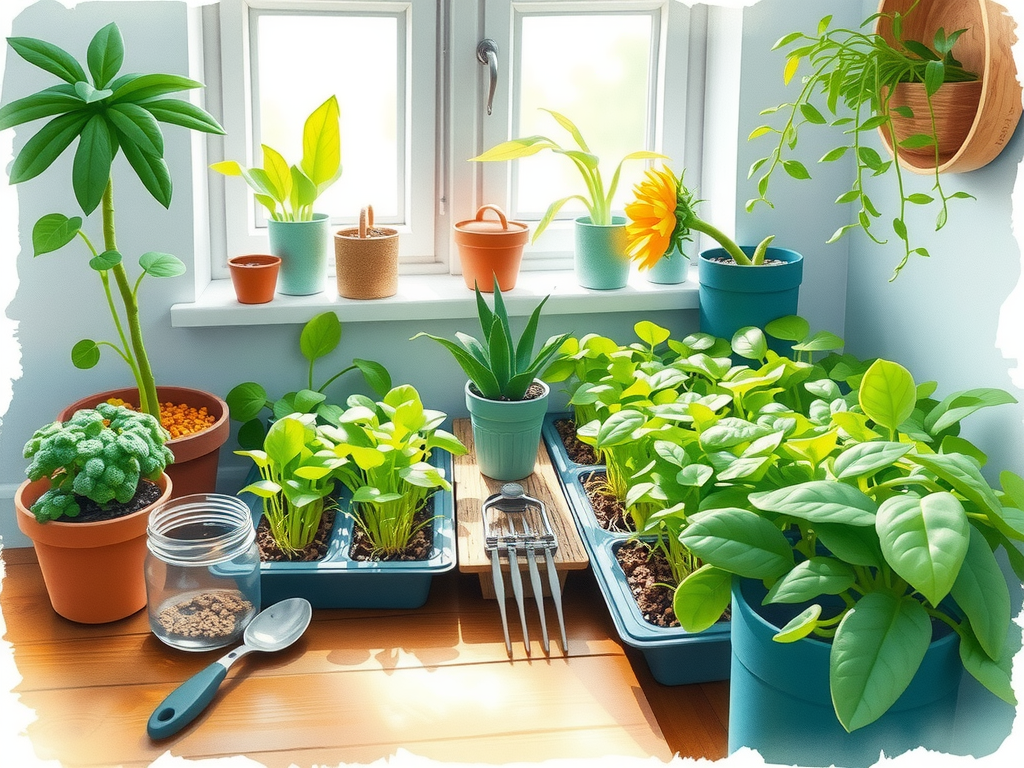
What Are The Best Seed Varieties
Choosing the right seeds is essential for successful microgreens. Diverse seed varieties enhance flavor and nutritional value.
Pea shoots are sweet, quick-growing, and yield high results.
Sunflower seeds offer a nutty taste and are rich in protein.
Broccoli sprouts provide important nutrients and are beginner-friendly. Radish microgreens have a spicy kick, while arugula leaves add a peppery flavor to dishes.
Experimenting with a mix of seeds can lead to an exciting harvest, improving taste and promoting various nutrients in your microgreens.
Best Microgreens for Beginners
Microgreens are young plants harvested early. They are nutrient-dense and quick to grow.
These varieties are ideal for beginners:
- Pea Shoots: Sweet flavor, rapid growth, and high yields.
- Sunflower: Nutty flavor, rich in protein, popular for juicing.
- Broccoli: Packed with nutrients, including sulforaphane, and easy to grow.
- Radish: Spicy flavor, fast-growing, and colorful.
- Arugula: A peppery addition to dishes, grows quickly and uniformly.
Light Requirements For Microgreens
Proper light exposure is critical for growth. Light affects photosynthesis and impacts growth rates and flavors. Using grow lights ensures consistent results, especially in indoor gardening.
Position lights 6 to 12 inches above seedlings for optimal performance. Natural light is best when available, but grow lights provide the necessary intensity year-round.
Providing sufficient light supports healthy growth and enhances flavor in your microgreens.
Tips for Light Management
To maximize the growth of your microgreens, consider these tips:
- Use grow lights for reliable results.
- Maintain a distance of 6 to 12 inches from seedlings.
- Check light intensity regularly to ensure it meets plant needs.
Microgreens
- Microgreens can contain up to 40 times more nutrients than their mature counterparts.
- Growing microgreens indoors can be done year-round, providing fresh produce regardless of the season.
- Proper light exposure can increase the growth rate of microgreens by up to 25%.
- Microgreens are ready to harvest in as little as 7 to 21 days, making them a quick crop for beginners.
Mastering The Germination Process
Successful sprouting depends on moisture control and seed variety selection. Moisture levels must be just right; this directly impacts germination success.
Seed selection also influences results, as some seeds germinate better in specific conditions.
Temperature is important, with an ideal range of 65°F to 75°F for germination.
A simple method for germination includes using damp paper towels:
- Moisten a paper towel without soaking it.
- Space seeds evenly on the towel.
- Fold the towel and place it in a plastic bag.
- Keep it warm until seeds sprout.
This method yields great results for easy microgreens to grow, such as pea shoots and sunflower greens.
Nutrient Density: Why It Matters
Microgreens provide not only flavor but also high nutrition. Nutrient density in microgreens can be 20-40 times higher than in mature plants. Including microgreens in meals boosts overall nutrition and enhances flavor.
A practical tip is to mix a handful of microgreens into smoothies. Pairing them with fruits like bananas or berries adds sweetness and nutrition to your drink. This incorporation makes them a great choice for a plant-based diet.
Best Microgreens for Beginners
Microgreens are young plants harvested early, making them nutrient-dense and quick to grow. They can be cultivated in minimal space and time. The following varieties are ideal for beginners:
- Pea Shoots: Sweet flavor, rapid growth, and high yields.
- Sunflower: Nutty flavor, rich in protein, popular for juicing.
- Broccoli: Packed with nutrients, including sulforaphane, and easy to grow.
- Radish: Spicy flavor, fast-growing, and colorful.
- Arugula: A peppery addition to dishes, grows quickly and uniformly.
| Microgreen Variety | Flavor Profile | Growth Rate | Nutritional Benefits |
|---|---|---|---|
| Pea Shoots | Sweet | Rapid | High yields |
| Sunflower | Nutty | Moderate | Rich in protein |
| Broccoli | Earthy | Easy | Packed with sulforaphane |
| Radish | Spicy | Fast | Colorful and nutritious |
How To Control Moisture For Success
Controlling moisture levels is essential for microgreens to flourish. Overwatering can lead to mold, while underwatering may cause wilting.
Both conditions negatively impact your germination process and healthy growth.
Using a moisture meter provides precise readings and helps maintain the ideal balance.
Moisture control is crucial to prevent common issues related to both extremes. Check your growing medium often and adjust your watering schedule accordingly.
The right moisture is vital for success in home gardening and enhancing the health benefits of your crops.
Culinary Uses Of Fresh Greens
Microgreens bring vibrant flavors and nutrients to any dish. They significantly enhance salads, sandwiches, and garnishes.
For example, pairing pea shoots with seafood creates a delightful contrast.
Adding radish microgreens to tacos provides an extra spicy kick.
High nutrient density is another reason to include microgreens in your meals. Regularly eating them can contribute to better overall health.
Culinary creativity thrives with versatile options like arugula leaves or sunflower greens, allowing you to elevate your cooking easily.
Best Microgreens for Beginners
Microgreens are quick-growing plants that are harvested young. They are easy to grow and nutrient-rich.
These varieties are perfect for beginners:
- Pea Shoots: Sweet flavor, rapid growth, high yields.
- Sunflower: Nutty flavor, rich in protein, popular for juicing.
- Broccoli: Packed with nutrients, including sulforaphane, and easy to grow.
- Radish: Spicy flavor, fast-growing, and colorful.
- Arugula: A peppery addition, grows quickly and uniformly.
Microgreens
- Microgreens can contain up to 40 times more nutrients than their mature counterparts.
- They typically take 7 to 21 days to grow, making them an ideal choice for quick harvests.
- Microgreens are known to improve heart health and lower cholesterol levels.
- They can be grown indoors year-round, providing fresh greens regardless of the season.
Tips For Container Gardening Microgreens
Container gardening microgreens offers a simple way to enjoy fresh greens at home. Start with easy-to-grow varieties like pea shoots and sunflower microgreens for a successful start.
These plants thrive in limited space, making them great for urban agriculture where space is at a premium.
Utilizing recycled containers not only reduces waste but also promotes eco-friendly practices.
Ensure containers have drainage holes for moisture control.
Microgreens need 12 to 16 hours of light daily for optimal growth.
Consider using grow lights if natural light is limited.
Maximize Your Space
Stacking containers vertically can help maximize your gardening area. This technique uses space efficiently while allowing easy access to your plants.
Experimenting with these techniques can lead to a rewarding indoor gardening experience.
Best Microgreens for Beginners
Microgreens are quick-growing plants that are harvested at an early stage. They are nutrient-dense and can be cultivated with minimal space, time, and equipment.
The following varieties are great for beginners:
- Pea Shoots: Sweet flavor, rapid growth, high yields.
- Sunflower: Nutty flavor, rich in protein, popular for juicing.
- Broccoli: Packed with nutrients, including sulforaphane.
- Radish: Spicy flavor, fast-growing, and colorful.
- Arugula: A peppery addition, grows quickly and uniformly.
Key Facts About Microgreens
Microgreens are harvested within 1 to 3 weeks after planting. They can be grown in small spaces with basic growing mediums like soil or coconut coir. Nutrient-dense microgreens are 20–40 times richer in vitamins compared to mature plants.
Ensure you provide sufficient light and moisture while avoiding overwatering to prevent mold growth. A blackout period during germination can help seeds sprout evenly. Starting with a few varieties will help you master growing techniques.
Growing microgreens year-round is possible with the right light sources. This makes them a sustainable and practical food source for any gardener.
Container Gardening Microgreens
- Microgreens can be harvested within 1 to 3 weeks, providing quick results for gardeners.
- They are 20–40 times richer in vitamins compared to their mature counterparts, making them a nutrient-dense food option.
- Utilizing recycled containers not only promotes sustainability but also helps reduce waste in urban gardening.
- Microgreens require only 12 to 16 hours of light daily, making them suitable for indoor gardening with the right light sources.

